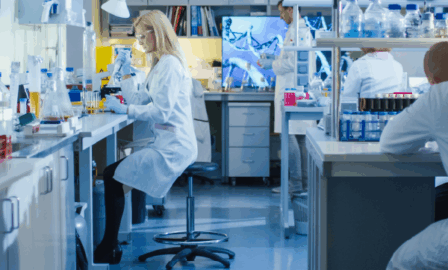Potential Life Sciences Application in the Metaverse: Lessons Learned from CPG and Retail
The metaverse has already demonstrated its potential to impact the consumer products and retail industries, engaging and connecting with shoppers and consumers in a new digital channel. But what about the life sciences industry? What are the metaverse’s potential applications in this enterprise space? While it’s impossible to define what the metaverse might look like five or 10 years from now, there’s certainly great potential for it to contribute to great innovation and collaboration in the life sciences.
Metaverse Applications in the Life Sciences Industry
For the sake of this conversation, let’s define the metaverse as not some kind of a monolith, but rather a loose collection of various technologies. Based on metaverse applications seen in the consumer products and retail sectors, here are a few emerging opportunities and potential applications for the life sciences industry:
Shopfloor Walkthroughs
The other day, I was walking the shop floor of one of our biotech clients on the East Coast. The purpose of the visit was to give the digital team a walkthrough of the quality control lab, the processes, the gaps, and the potential areas for improvement. While none of us were or needed to be hands-on here, this gave a great perspective on how we could digitize some of these processes.
All of us had come from different parts of the country for the walkthrough. But, could it have been done any easier without all the air travel, hotels, and advanced planning needed to coordinate multiple people’s schedules – particularly for just a one-hour site visit? If this were simulated in a virtual reality (VR) environment, we could have all done the walkthrough from the confines of our own offices and had an equally effective discussion.
Employee Training
Let us extend this further. What if we could deploy formal training using VR? While it’s uncertain if this will pass muster from the regulatory bodies (GxP training), at least for now, a VR-based curriculum can certainly add value and provide exposure and much-needed practice before the formal training. Since this is digital, it can continue to be used for refresher training as well. A few other training scenarios include:
- New shop floor personnel operating critical equipment
- Introducing new products and processes
- Field and customer service personnel
- Introductory training for your HCPs (healthcare providers)
Two companies making strides in this direction are Virtuosi and Lucid Dream, and it’s only a matter of time before there are others.
Co-location Collaboration
While many businesses will be able to realize this benefit, the potential impact to the life sciences space specifically is significant. Do you have globally dispersed employees that you want to bring together for a meeting, but you’re constrained by costs, travel restrictions, COVID regulations, etc.? Consider this: there are tools that – with the aid of a VR headset – give you an immersive experience, replete with avatars (a little quirky, yes) and spatial sound. While this doesn’t give you the flesh-and-blood feeling that only a physical meeting can provide, this helps address some of the need for co-location collaboration for sure. Some of these options include Meta’s Horizon Workrooms for a real immersive VR-based experience, and solutions, like gather.town, that simulate an office-like environment without needing VR.
Digital Twins
Digital twins are digital replicas of a process, product, structure, etc. This provides the ability to simulate, test, and try processes, products, or structures in the digital world before building them out in the real world. The applications are many, including drug development and setting up manufacturing facilities, and companies like Sanofi have already started leveraging the technology for these purposes. Companies, such as NVIDIA and Dassault are providing the necessary platform for companies to use the metaverse for these applications. Digital twins can really move the needle and disrupt the industry, and life sciences companies need to be exploring this space.
Looking Ahead
While still in the early stages, the various technologies making up the metaverse have immense potential to impact the life sciences industry in the next coming years. If you’re a life sciences company, the minimum you can do NOW is to start thinking about these applications, evaluate if there are scenarios in your business that could benefit from the technologies, and identify the potential for getting a pilot going.
And, just as importantly, get your team interested and educated about the metaverse – we’ve already seen its impact in the consumer products and retail industries, and there’s great potential for more to be done in the life sciences space, too.



